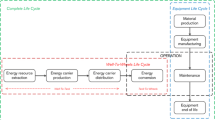Abstract
Goal, Scope, and Background
Despite documentation of product lifetime, performance, and system dependency issues, requirements for specifying functional units and reference flows in LCA have not been developed. The ISO standards simply note that selection between functions is dependent on the goals and scope of the study, that the functional unit must be clearly defined and measurable, and that the reference flows are the amount of product necessary per functional unit. The goal of this work is to suggest and demonstrate the use a set of requirements for specifying the functional unit and reference flows for comparative LCAs.
Methods
The suggested requirements were developed to address the lifetime, performance, and system dependency issues described in LCA literature and to ensure adequate information is available for the interpretation of results. Also, well developed methods for conceptual design were used to formulate aspects of the requirements to improve comparability of alternatives. A case study demonstrates the use of the requirements in materials selection for aircraft design. In the case study, functional units are specified for the component being designed and for the aircraft. Similarly, reference flows for the component, component interfaces, and the aircraft are quantified based on parametric and linear estimation models. Finally, an interpretation of data quality, uncertainty, assumptions, and limitations are presented.
Results and Discussion
The requirements are shown to be particularly important when the product be assessed operates as part of a larger system and when there are performance differences among alternatives. The case study illustrates the importance of including consideration of system and interface materials and energy flows in the comparison of aircraft components. Specifically, because the mass of interface materials is estimated as more than the difference in subsystem masses, differences in the variable mass of the aircraft and the lifetime fuel consumption are accounted for in the reference flows.
Conclusions
Some practitioners have recognized difficulties in accounting for product lifetime, performance, and system dependencies in LCA, even though a set of requirements has not been included in literature or in the ISO standards. The suggested requirements presented in this work were found to be useful in accounting for differences in materials and energy flows and in providing a transparent presentation, assessment, and interpretation of reference flows and ultimately in the LCA results.
Recommendations and Outlook
This work is significant because the specification of the functional unit and the definition of the reference flows dictate the materials and processes included in the LCA. Future work is needed to test the general applicability of the suggested requirements to a wide variety of product systems.
Similar content being viewed by others
References
Ashby M (1999): Materials Selection in Mechanical Design. Butterworth Heinemann, London
Dermondy J (1994): Guidelines on Developing Environmentally Responsible New Products. PhD Thesis to the Bristol Business School of the University of West England, Bristol/UK
Design Center Stuttgart (1991): Materials Design and Ecology. Office for National Trade Baden Württemberg (Hrsg.) Stuttgart
Dieter G (2001): Engineering Design a Materials and Processing Approach. McGraw Hill, New York
Federal Aviation Administration (1998): Economic Values for Evaluation of Federal Aviation Administration Investment and Regulatory Decisions. US Department of Transportation, FAA-APO-98-8
Frischknecht R (1997): LCANET Theme Report Goal and Scope Definition and Inventory Analysis. Swiss Federal Institute of Technology, Zürich
Granta Design (2000): Cambridge Engineering Selector, Version 3.1
Haas G, Wetterich F, Geier U (2000): Life Cycle Assessment Framework in Agriculture on the Farm Level. Int J LCA 5 (6) 345–348
Hale FJ (1984): Introduction to Aircraft Performance, Selection, and Design. John Wiley and Sons, New York, pp 268–271
Heijungs R, Suh S (2002): The Computational Structure of Life Cycle Assessment. Kluwer Academic Publishers, Dordrect
Henzi V, Reyburn B, Wiemers D, Cooper JS (2001): Life Cycle Assessment of Composites and Aluminum Use in Aircraft Systems: Interim Project Report. Prepared for the Boeing Company, Seattle, Washington
International Standards Organization (1997): Environmental Management Life cycle Assessment Principles and Framework. ISO 14040-1997 (E)
International Standards Organization (1998): Environmental Management Life cycle Assessment Goal and scope Definition and Inventory Analysis. ISO 14041-1998 (E)
Keoleian GA, Menerey D (1993): Life Cycle Design Guidance Manual, environmental requirement and the product system. US EPA Report Number EPA/600/R-92/226, Cincinnati, OH
McCleese DL, LaPuma PT (2002): Using Monte Carlo Simulation in Life Cycle Assessment for Electric and Internal Combustion Vehicles. Int J LCA 7 (4) 230–236
National Academy of Sciences (1993): Materials Research Agenda for the Automobile and Aircraft Industries. Published by the National Academy of Sciences
Pahl G, Beitz W (1996): Engineering Design a Systematic Approach. Spinger, Great Britain
Polmear IJ (1996): Light alloys: metallurgy of the light metals. John Wiley and Sons, New York
Reppe P, Keolian G, Messick R, Costic M (1998): Life Cycle Assessment of a Transmission Case: Magnesium vs. Aluminum. SAE Technical Paper 980470
Ruhland A, Striegel G, Kreisel G (2000): Functional Equivalence of Industrial Metal Cleaning Processes: Comparison of Metal Cleaning Processes Within LCA. Int J LCA 5 (3) 127–133
Sauer BJ, Franklin WE (1997): How to perform a Life Cycle Inventory. Proceedings of the 1997 Total Life Cycle Conference Life Cycle Management and Assessment (Part 1), Society of Automotive Engineering, pp 167–189
Society of Allied Weight Engineers (1996): Introduction to Aircraft Mass Engineering. Society of Mass Engineers, Los Angeles, CA
Wenzel H, Hauschild M, Alting L (1997): Environmental Assessment of Products Volume 1: Methodology, tools, and case studies in product development. Chapman and Hall, New York
Young SB, Vanderburg WH (1994): Applying environmental lifecycle analysis to materials. Journal of the Minerals, Metals and Materials Society 46 (4) 22–27
Author information
Authors and Affiliations
Corresponding author
Rights and permissions
About this article
Cite this article
Cooper, J.S. Specifying functional units and reference flows for comparable alternatives. Int J LCA 8, 337–349 (2003). https://doi.org/10.1007/BF02978507
Received:
Accepted:
Issue Date:
DOI: https://doi.org/10.1007/BF02978507




